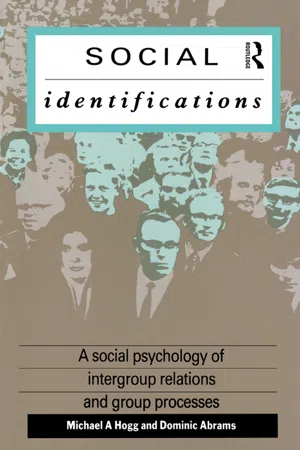Psychology
Conformity to Social Roles
Conformity to social roles refers to the tendency of individuals to adopt behaviors, attitudes, and beliefs that align with the expectations associated with their specific social roles. This concept is often studied in the context of social psychology, where researchers explore how individuals conform to the norms and expectations of their roles within various social groups and institutions.
Written by Perlego with AI-assistance
Related key terms
7 Key excerpts on "Conformity to Social Roles"
- eBook - ePub
Social Identifications
A Social Psychology of Intergroup Relations and Group Processes
- Dominic Abrams, Michael A. Hogg(Authors)
- 2006(Publication Date)
- Routledge(Publisher)
intra group phenomenon whose analysis must reside in a systematic theoretical treatment of the nature of the social group. We shall build upon this reasoning below when describing the social identity approach to conformity.Although norms occupy an important position in sociological enquiry, this is not so obvious in social psychology, where the concept, when invoked, is rarely employed in a capacity other than that of common parlance. In experimental social psychology, the consideration of norms is largely restricted to the early work of Sherif (1936), Asch’s conformity research (Asch 1952), and more recent writings by Rommetveit (1969) and Moscovici (1976). Later, it should become clear that social representations (Farr and Moscovici 1984; Moscovici 1961), social stereotypes and social belief structures (Tajfel 1981b; Tajfel and Turner 1979), orthodoxy (Deconchy 1984), and ideology all have relevance to the concept of norm, as does the entire framework of the self-categorization theory of group behaviour (Hogg and Turner 1987a; Turner 1985; Turner et al. 1987; Wetherell, Turner, and Hogg 1986).Before proceeding it should be emphasized that conformity can broadly be distinguished from other social influence phenomena in that the behavioural content is normative: it represents a group which it differentiates from other groups and thus contains information about social rather than personal identity. Nevertheless, the very nature of norms is such that most behaviour concerns information about group membership and identity, and hence that most social influence phenomena contain an element of conformity. For example, compliance with a request to select a book to read (hardly conformity in any sense other than conformity to a generic norm for compliance with requests), may contain an element of conformity to group norms as revealed by the specific choice of book. Similarly, while voting may be compliance with a law (in some countries) that compels voting, voting choice - eBook - ePub
- Kevin Wren(Author)
- 2013(Publication Date)
- Routledge(Publisher)
2
Conformity
Introduction Mustafer Sherif and informational social influences Solomon Asch and normative social influences Informational and normative influences Richard Crutchfield Conformity/non-conformity and physiology Factors that may influence the degree of conformity Evaluation of conformity experiments Explaining the conformity effect SummaryIntroduction
Throughout our daily lives we conform, i.e. we behave in response to the perceived pressure of others. We queue, wait at bus stops and conform to road signs. In other situations our conformity is subtler. When in a group we often ‘go with the flow’ while at the same time having some private reservations about what we are doing. In such face-to-face contact with a group we are under pressure to conform to the beliefs, actions and attitudes of the ‘greater’ group. In this respect our behaviour can be governed by a number of social influences of which obedience and conformity to group influences are examples. We need to be careful here not to confuse behaviour changed as a result of conformity and behaviour changed as a result of obedience. Although definitions differ slightly from psychologist to psychologist the following differences can be observed:In this chapter we are going to examine material that deals with behaviour altered as a result of manipulating group pressure, i.e. conformity.• In conformity situations behaviour changes as a result of group pressure, despite there being no explicit requirement on the part of individual participants to change. In this respect behaviour within the group becomes more homogenous.• In obedience situations behaviour changes as a result of the explicit instructions of an authority figure, i.e. the experimenter. In this respect behaviour arises out of the fact that social structure is differentiated, i.e. the experimenter begins with a higher status. (after Evans, 1980) - eBook - ePub
- Jane Callaghan, Lisa Lazard(Authors)
- 2011(Publication Date)
- Learning Matters(Publisher)
Chapter 4 , social influence refers to the way that the thoughts, feelings and behaviours of one person (or a group of people) are influenced by the real, imagined or implied presence of other people. Three forms of social influence should be distinguished.- Compliance involves changing your behaviour on the instruction or under the influence of another. It also involves a response to a direct instruction from another person. Compliance differs from persuasion in the sense that compliance targets behaviour change (regardless of shift in attitude), while persuasion is intended to change people’s attitudes.
- Obedience involves compliance with the instructions of an authority figure.
- Conformity involves changing your attitudes or opinions as a result of social pressure. This can include conformity to the behaviour or a group, conformity in large groups (crowd behaviour , or what is sometimes termed ‘mob psychology’) and conformity to social norms.
Think about the way you dress, the way you style your hair, the kind of shoes you wear. How much of this is really individual choice, and to what degree is it influenced by issues such as fitting in, following a style or trend etc.? Even the least fashion-conscious person in the world will often still dress with a sense of what might be appropriate (or if they wish to shock, inappropriate) to the context they are in. We often dress to blend in, or to stand out, but either way there is an element of social influence in our choices. Conformity is often represented as a negative thing – as in the case of ‘peer pressure’. However, is fitting in always a bad thing? To what degree is a level of conformity necessary for social life?In this chapter, we will consider various social-psychological perspectives on social influence at the individual and at the group level. We will be asking questions such as: what makes us comply with the wishes of others? Why might we obey the instructions of an authority figure? How and why do people conform? How do groups influence our behaviour? What about resistance to conformity pressures?Compliance and obedience
Compliance involves acceding to the request of another person. The request might be explicit (‘Go to the office and fetch my case’) or implicit (as in the case of some of the less direct forms of social influence considered in Chapter 4 - eBook - ePub
- Richard Gross, Rob McIlveen(Authors)
- 2016(Publication Date)
- Routledge(Publisher)
8 Social influence• Introduction • Compliance • Conformity or majority influence • Group polarisation • Obedience to authority • The influence of roles • Minority influence • Application: group polarisation in a legal context • Summary • Suggestions for further reading8.1 IntroductionThroughout our lives attempts are made, either directly or indirectly to influence the way we think, feel and behave. Similarly, we spend much time in social interaction attempting to influence others to think, feel or act as we do. Indeed, the continuance of any society demands a degree of conformity to social norms; society demands people comply with requests and obey authority at times. Yielding to social influence of whatever type or form is often counter to maintaining a sense of identity. An individual is often placed in a conflicting situation of needing to maintain his or her own sense of identity and independence while at the same time being required or expected to conform, obey or comply with other people’s wishes, prevailing norms, or standards. Failure to fall in with the ‘crowd’ or one’s peer group may incur painful penalties – ranging from ostracism to imprisonment if a law has been broken; while failure to achieve and maintain a sense of identity may result in low self-esteem, low self-confidence and, in more extreme cases, depression and apathy. Social influence may be either readily accepted by a person, both consciously and unconsciously, or yielded to reluctantly or resisted.The act of allowing oneself to be influenced by others should not necessarily be seen as negative or over-coercive. A person who conforms to something for which they had no strong beliefs may be saving themselves effort. The source of influence may not be from other people but the demand characteristics of the situation, for example, entering a church or a library elicits a particular behavioural response with no direct influence or pressure from others (Howitt et al - eBook - ePub
- Kenneth S. Bordens, Irwin A. Horowitz(Authors)
- 2013(Publication Date)
- Psychology Press(Publisher)
As we know, Frank ultimately decided to disobey the judge’s authority. He changed his vote to not guilty. However, consistent with what we now know about social influence, he was not convinced. His behavior change was brought about primarily through normative social influence. This is reflected in the sentiment he expressed just before he changed his vote: He changed his vote so as not to hold up the jury but he would “never feel right about it.”Chapter Review- What is conformity?
Conformity is one type of social influence. It occurs when we modify our behavior in response to real or imagined pressure from others. Frank, the man cast into the role of juror in a criminal trial, entered the jury deliberations convinced that the defendant was guilty. Throughout the deliberations, Frank maintained his view based on the information he had heard during the trial. However, in the end, Frank changed his verdict. He did this because of the perceived pressure from the other 11 jurors, not because he was convinced by the evidence that the defendant was innocent. Frank’s dilemma, pitting his own internal beliefs against the beliefs of others, is a common occurrence in our lives. We often find ourselves in situations where we must modify our behavior based on what others do or say.
- What is the source of the pressures that lead to conformity?
The pressure can arise from two sources. We may modify our behavior because we are convinced by information provided by others, which is informational social influence . Or we may modify our behavior because we perceive that a norm , an unwritten social rule, must be followed. This is normative social influence . In the latter case, information provided by others defines the norm we then follow. Norms play a central role in our social lives. The classic research by Sherif making use of the autokinetic effect showed how a norm forms.
- What research evidence is there for conformity?
Solomon Asch conducted a series of now-classic experiments that showed conformity effects with a relatively clear, simple perceptual line judgment task. He found that participants conformed to an incorrect majority on 33% of the critical trials where a majority (composed of confederates) made obviously incorrect judgments. In postexperimental interviews, Asch found that there were a variety of reasons why a person would conform (yield) or not conform (remain independent).
- eBook - ePub
- Matt Jarvis(Author)
- 2005(Publication Date)
- Routledge(Publisher)
7 Social psychology
Key assumptions of the approach Obedience and agency Prejudice and social identity Social constructionism Key application: tackling racism Contemporary issue: lesbian and gay psychology Contributions and limitations of social approaches SummaryKey assumptions of the approach
Think back to someone you have spoken to in the last 24 hours. In what ways was your behaviour influenced by that person, and how might you have influenced them? Did you find them attractive or cool? If so, why? Did they belong to a group that you have positive or negative feelings about? If so, did you show your feelings? If not, why not, and how did you conceal your reactions to them? You begin to see the complexity of social psychology, but also its relevance to all of us. Every time we interact with someone else we are potentially involved in a huge number of social processes. When most people say they are interested in psychology it is really social psychology—the study of human interaction—that they mean.The previous four chapters began with a typical study used to illustrate that particular approach. Trying to find a typical social-psychological study is a bit like trying to identify a typical person. They are simply too diverse. Social psychologists have used a tremendous variety of methods to investigate people’s social behaviour. In this chapter we will be looking at research ranging from experiments in which participants are ordered to give people fatal electric shocks in order to see whether they will obey a person in authority (Milgram, 1963), to an analysis of the political implications of the language people use to talk about rape (Doherty and Anderson, 1998). Given that social approaches to psychology vary so widely, it is important to identify the key assumptions that tie social psychology together. - eBook - ePub
Social Psychology
The Basics
- Daniel Frings(Author)
- 2018(Publication Date)
- Routledge(Publisher)
Across these two chapters we will explore how, why and when we conform to others’ demands, the effects of groups on our performance, how society deals with people who won’t conform to the prevailing view and how such minorities can cause major social shifts. We also explore the theory and practice of persuasion by investigating the extent to which we are rational thinkers, how irrelevant information such as mood and colour influence us, and how the science of persuasion is applied to marketing and public policy.As you read this, consider the sources of social influence in your own life and, perhaps, the ways in which you also exert your own influence on your social world.Passage contains an image
6 Conformity and obedienceConformity versus obedienceWe can all think of times when we tried to get someone to behave the way we wanted them to. We can also think of times we may have conformed to comply with other people’s expectations. This chapter will examine the processes underlying conformity and obedience. Obedience is typically defined as following orders from someone in authority. Importantly, when someone is obedient they do not necessarily have to agree with the behaviour – rather, they must comply with it. Obedience can be a useful process: many organisations require that people do what they need to even if they don’t always agree with the actions (consider what would happen if a school full of children could do exactly what they liked!). However, as we will see, it can also lead to people behaving in ways that they feel very uncomfortable with – to the point that their actions clash with their core moral values.In contrast to obedience, conformity is usually seen as behaving in line with the way the group wishes or expects (i.e. the social norms the group has; see Chapter 5 ). Again, conformity has many benefits: recall that Festinger argued that having a sense of social reality (which requires conformity to some extent) is an important part of ‘being a group’, with all the psychological benefits that come with that.In this chapter, we’ll examine ideas around conformity and obedience by looking at a number of classic studies exploring how people conform, and are obedient to, authorities in groups. We will also look at how groups can influence one to behave differently (for instance, by working harder or becoming more extreme in one’s opinions) and how we respond to people who fail to conform. Finally, we will explore how minorities can sometimes not only not conform but also change the social norms of the majority.
Learn about this page
Index pages curate the most relevant extracts from our library of academic textbooks. They’ve been created using an in-house natural language model (NLM), each adding context and meaning to key research topics.






